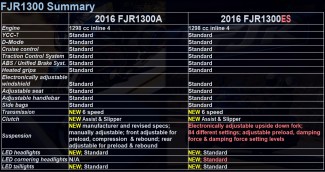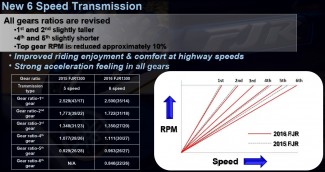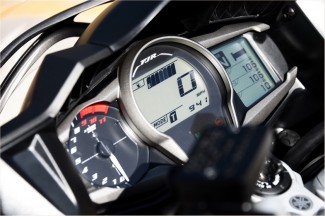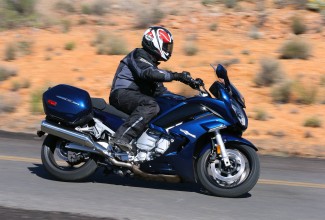I just returned from testing the 2016 Yamaha FJR1300 models (each the A and the ES) in Arizona, and have the following report (each written and video). Before we get started with my riding impression, let’s review the specifications of the bike, specifically what is new for 2016.
Yamaha’s FJR1300 has been about in the very same simple configuration considering that it was introduced back in 2003. That original FJR had a really contemporary engine design with lots of displacement and torque, and Yamaha, rather than radically adjust the model, has focused on periodic refinement. The large 1298 cc inline four, for instance, gained much more sophisticated characteristics, which includes ride-by-wire throttle, adjustable engine maps, traction control and cruise manage.
MD last tested the FJR1300 in 2013 when new styling and many of the electronic aides had been 1st introduced. We had been again impressed that the adjustments created by Yamaha properly enhanced an currently outstanding sport tourer. Now, we have created our first evaluation of the changes for 2016. The following table summarizes the modifications to both the 1300A and 1300ES:
If you have been following the development of the FJR1300, you know that it is a single of the final, modern day sport touring motorcycles to function a 5-speed transmission. In the past, both owners and journalists have typically stated some thing like “This large, torquey engine only requirements 5 speeds”, and that was true. But “needs” does not usually equal “wants”, and the new six-speed transmission in the 2016 models make a huge difference.
If you didn’t feel your old FJR was buzzy or busy feeling at highway speeds, riding the 2016 FJR might change your mind. Sixth gear is 10% higher than final year’s fifth. It could not sound like significantly, but the drop in rpm levels at highway speeds tends to make the huge FJR feel noticeably more relaxed … refined, even. Undoubtedly, decrease rpms whilst cruising the highway will also increase fuel economy.
It is not just the new sixth gear, nonetheless, that tends to make a difference for 2016. The gear spacing in the decrease gears feels significantly improved, as effectively. With an additional cog, the reduce gears can be spaced much more tightly — leaving the rider with the appropriate gear for the right moment more usually, and regularly with at least two gears offered to do the job at hand. Additionally, Yamaha moved from straight reduce to helical gears for 2016, significantly decreasing “gear lash” — furthering the sense of refinement. For reference, here is some details on the gear spacing modifications for 2016:
Also new for 2016 is the “Assist & Slipper Clutch”, which makes use of engine acceleration and deceleration forces to boost and reduce clutch engagement where suitable. So in addition to the benefits of a slipper clutch (smoother corner entry, for instance), Yamaha was capable to minimize the spring tension in the clutch basket to allow for an less complicated clutch pull (Yamaha claims 20% much less work).
Each models also acquire new LED lighting for 2016, which includes headlight, taillight and turn signals. The 1300ES also receives 3 extra headlights that engage progressively as the bike leans into corners, illuminating by means of the corner. We discussed this feature in an earlier report. Given that we have not ridden either model in the dark, we can not comment on the effectiveness of this feature. We will test this when we get a test unit from Yamaha for a complete ride assessment.
The FJR1300A has new suspension for 2016 from KYB, replacing the prior suspension manufacturer for this model. The fork is a really beefy 48mm, with full adjustability, although the shock is adjustable for rebound and spring preload. Of course, the new suspension units have different damping traits that we had been able to test.
The instrument cluster has also been revised, and involves an anti-glare therapy. We identified the legibility and contrast of the LED readouts excellent, even in bright daylight (a direct sun bounce off the face of the gauges is nevertheless a difficulty, but that is to be expected). Handlebar controls continue to enable the rider to adjust several attributes, like heated grip temperature, windshield height and, with the ES model, suspension settings that range from single rider with no luggage to rider and passenger with luggage. Deeper menus permit fine tuning of settings such as grip warmth and suspension damping levels. Certainly, there is so considerably adjustability it takes a bit of studying, but eventually it is logical and simple to remember how to access distinct functions and make adjustments.
Other returning, standard attributes consist of a enormous six.six gallon fuel tank ride-by-wire throttle with two selectable engine maps (including Sport and Touring), the aforementioned cruise handle and traction control, ABS brakes (including, actuation of a single front brake caliper piston when utilizing the rear brake pedal), the electronically adjustable windshield and 12 volt energy outlet.
The saddlebags are regular, as properly, and each of them will accommodate most large, full-face helmets (such as my huge Arai). The ergonomics are adjustable in that there are two seat heights obtainable (20 mm range of adjustment) and the handlebars can be slid either 5 mm closer to, or further from, the rider.
We rode both models with the seat in the standard, taller position and the handlebars in the standard, central position. The reach to the ground was reasonable for my 5’11” frame (not fully flat footed, nevertheless), and the reach to the bars needed a really slight forward lean (not fairly bolt upright). The seat is firm and really supportive, and in basic I found each FJRs extremely comfortable. A lengthy stint in the saddle, droning down the highway, did yield some discomfort. Some riders, specifically these who tour a lot, will benefit from an aftermarket seat, but most riders won’t bother altering it. The riding position itself felt close to best for long-distance touring.
Wind protection is outstanding, and several riders will be in a position to dial in a windshield height that minimizes buffeting at the helmet level. Taller riders might hold the windshield in a reduce position in order to offer smooth air flow at helmet level, nevertheless.
A reasonably light throttle return spring and noticeably lighter clutch pull also support on longer rides, as does the normal cruise manage that is quite effortless to engage and even fine tune (add or subtract 1 mph at a time) with a simple push of the left thumb. There are also air louvers in every of the side fairing panels that permit adjustment of air flow to the legs.
Throttle response and fuel injection mapping is nigh perfect (Sport mode is a bit snappier in its response, but still linear and predictable). The smooth throttle acts with each other with the lowered gear lash and slipper clutch to make riding, including aggressive riding, simple and far more controllable. Whether or not opening the throttle on corner exits or quickly down-shifting on corner entries, the massive FJR stays poised and balanced. Fairly impressive stuff.
Acceleration is powerful in the decrease gears and adequate at highway speeds in the overdrive sixth gear. If you are loafing along in sixth gear under 70 mph, a swift downshift may possibly be required to pass, especially two-up with luggage, but usually the bike has adequate grunt to do the job even at rpm levels beneath four,000. Just like any other inline 4 there is some vibration, probably most noticeable about 5,000 rpm (properly above highway cruising speed in sixth). Vibration is effectively controlled, even so, and it by no means became an issue or caused any substantial discomfort in the course of our test.
The new suspension on the 1300A worked really well. Smooth sufficient for touring, it was only slightly less plush than the electronic suspension on the ES (which absorbs modest, choppy bumps superbly). Far more impressively, the non-electric suspension on the 1300A, specifically the fork, provided superb feel and feedback that generated self-assurance while cornering and braking. The Bridgestone tires contributed right here, as properly, with excellent cornering grip and decent bump absorption compliance.
The brakes offered excellent power and really feel, and the linking function (which engages a single front piston when the rear brake is applied) became invisible to me while riding at most speeds (generally, linked brakes annoy me due to the fact I have a distinct corner entry strategy with the rear brake). Initially, for the duration of quit-and-go riding in town, I felt even a light application of the rear brake resulted in a somewhat abrupt reaction from the front finish (including mild brake dive). I stopped noticing this tendency, as well, after riding the bike a bit much more.
One more “nanny” feature I didn’t care for, at very first, involves Yamaha’s selection to add an added 200 rpm as you let the clutch out from a stop. Intended by Yamaha to decrease stalling, initially an knowledgeable rider will basically really feel that he/she has lost exacting control of the throttle when leaving a cease. This sensation seemed to go away at some point, as effectively.
Each the 1300A and ES deal with very nicely for their size (claimed wet weight in the neighborhood of 640 pounds). With the six.six gallon fuel tank freshly topped off, there is an increased sense of best heaviness, but usually both FJRs really feel comparatively compact and light for luxury sport tourers. Kawasaki’s Concours 14 weighs roughly 50 pounds far more, by comparison, and has a slightly taller regular seat height.
With very good leverage at the bars, the FJR can be hustled via the twisties with out as well much work, and can even alter directions fairly quickly. The video beneath might give you some sense of this reality. Mid-corner, the FJR is also steady and composed, and largely undisturbed by most bumps.
At greater speeds on the highway, the FJR is also quite stable and composed … just as a extended-distance tourer must be. With the superb cruise handle, comfortable rider triangle, nicely damped suspension and ample wind protection (including electrically adjustable windscreen that can quit anyplace within a generous five.1″ range), the FJR is ready to ride as far as you may well like. The truth that you can also get pleasure from a romp through a tight canyon road to break the monotony of the superslab adds to the return on your investment.
Primarily based on our initial ride of each models, it appears Yamaha has once more enhanced an outstanding platform for riders that are searching for a luxury sport tourer. The FJR1300A is priced at an U.S. MSRP of $ 16,390, whilst the FJR1300ES is $ 17,990. Both models are offered in the single Blue color pictured. The bikes are offered now at U.S. dealers (despite the fact that California models are not available till April). For extra specifics and specifications, go to Yamaha’s internet web site. You can also take a appear at our video right away below.
See far more of MD’s wonderful photography:
2016 Yamaha FJR1300A and 1300ES: MD 1st Ride (with video) (Bike Reports) (News)









Hiç yorum yok:
Yorum Gönder